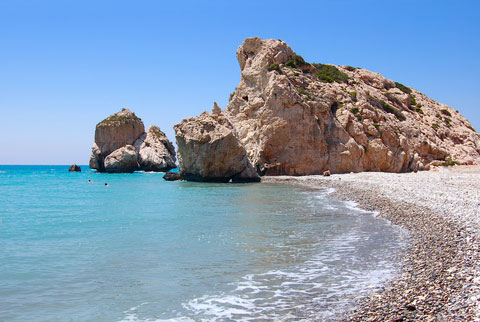Cyprus island is an intriguing place. It has had a sad history (read Lawrence Durrell’s ‘Bitter Lemons’ for a writer’s view), but the magic of the island remains. The island is at a crossroads between East and West. Because of its position in the Mediterranean it has been under many influences, from ancient Greece to Muslim and Greek today.
Sadly, today the island is still divided in two, with the Greek section in the south, and the Turkish in the north. Having lived side by side for centuries, the island became divided in 1974, with the Turkish Cypriots declaring independence in northern Cyprus in 1983.
Differences have still not been resolved. The presence of so many tourists on the island has probably helped to keep stability. Both north and south know how much they now depend on tourism for their livelihoods.

Mythology
As with anything to do with ancient Greece, in the beginning there was mythology. And the earliest myth claimed that Cyprus island was the birthplace of Aphrodite. There’s a place on the south west coast called Petra tou Romiou where a large rock lies just off the beach. She is supposed to have emerged from the waves at this very stop. Botticelli’s masterpiece ‘The Birth of Venus’ is the most well known painting depicting the scene, as Aphrodite comes out of the sea on a seashell.
Even if you didn’t know this story you couldn’t travel through the island without realizing that Aphrodite has something to do with the place because of all the tavernas and restaurants named after her.

Bronze age and beyond
During the Bronze Age (2500 – 1050 BC) immigrants arrived both from Anatolia (modern Turkey) and Mycenaeans from the Greek mainland.
In the Iron Age (1050 – 400 BC) the art of metallurgy grew, as did a ceramics industry. This led to new settlements and cities, such as Salamis on the north of the island. The Phoenicians conquered it in the 10th C BC, and they were followed by the Assyrians, Egyptians, and then the Persians. The exploits of Alexander the Great in defeating the Persians at Tyre, on the coast of Palestine, freed the island from the Persians.
This was the start of the Hellenistic period, and from then on the culture of Cyprus island became predominantly Greek.
Situated as it is in the Mediterranean, the island couldn’t fail to be noticed by the Romans, who of course couldn’t fail to act in their traditional fashion and conquer and rule it.
From then on it was ruled by the Byzantines, Arabs, Byzantines again, Knights Templar, Lusignans (Franks), Venetians (you find them all over the Mediterranean in the middle ages), Turks, British, and finally the situation today.

What is there to see from the ancient Greek period?
With all those different groups having a go at the island over the millennia, it’s a wonder there is anything left. But there are a few sites which reward the visitor for spending time there.
In the northern part of the island is Salamis, the most impressive archaeological site you’ll find. (If you’re staying in the southern Greek part of the island you’ll need to make arrangements to visit.) The remains visible today are mainly of Roman origin, with some tombs from earlier times. Also in the north is Vouni, with the earliest remains dating from the 5th C BC.
Kourion on the south coast is the most important site after Salamis. It has a wonderful theatre, with spectacular views over the Mediterranean. Paphos, in the south west, has many interesting finds, although it isn’t as old as some sites, originating in about 300 BC. The Roman mosaics here are not to be missed.
So while there are no great Mycenaean or Classical Greek sites to see in Cyprus island, there is still plenty of history to hold your interest. You can see where the places mentioned here are on a Cyprus map.

